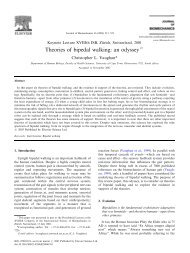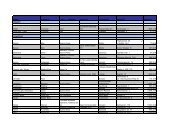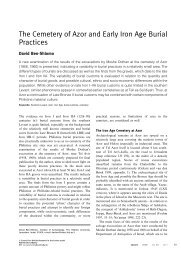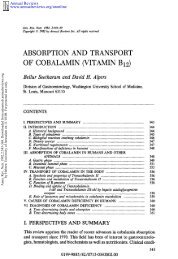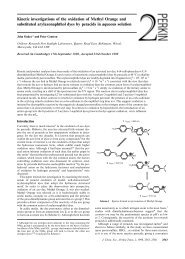The Riddle of Ramat Raḥel: The Archaeology of a Royal Persian ...
The Riddle of Ramat Raḥel: The Archaeology of a Royal Persian ...
The Riddle of Ramat Raḥel: The Archaeology of a Royal Persian ...
Create successful ePaper yourself
Turn your PDF publications into a flip-book with our unique Google optimized e-Paper software.
15Jerusalem, Samaria continued to exist without interruption from the late 8th to the 4th centuriesBCE as the political and administrative center <strong>of</strong> the province <strong>of</strong> Samaria, and its 8th centuryfortifications continued to exist until the end <strong>of</strong> the <strong>Persian</strong> period and probably even during theHellenistic and the Roman periods (Lipschits 2006: 20, note 5).<strong>The</strong> well planned garden at Samaria, which probably continued to function from the Late IronAge, probably to the "post-Assyrian phase" at the site to the <strong>Persian</strong> period, is the only otherindication we have in the hill country <strong>of</strong> Israel, beside <strong>Ramat</strong> <strong>Raḥel</strong>, <strong>of</strong> a central imperial andadministrative center. Since at Samaria the site served as the residency <strong>of</strong> the governor <strong>of</strong> theprovince, it is one <strong>of</strong> the indications we have on the role <strong>of</strong> <strong>Ramat</strong> <strong>Raḥel</strong> during the <strong>Persian</strong> period.<strong>The</strong> abandonment <strong>of</strong> the edificeAnother sub-phase <strong>of</strong> building activity that took place during the <strong>Persian</strong> period was found inArea C1, within the garden enclosure and south <strong>of</strong> the western tower. This building operationmarks the decline <strong>of</strong> the edifice and possibly the takeover <strong>of</strong> parts <strong>of</strong> the garden for other more"functional" purposes. It includes building 824 <strong>of</strong> an architectural unit in the southeastern part <strong>of</strong>the enclosure. In constructing this unit, the eastern and southern escarpments were used as walls.Large ashlars were robbed from nearby structures and placed against the escarpment to prevent itscollapse. <strong>The</strong> northern and western walls <strong>of</strong> the unit were built <strong>of</strong> similar ashlars, in secondary use.<strong>The</strong> floor <strong>of</strong> the unit covered Channel E. We noted that the floor <strong>of</strong> the architectural unit was laidafter the cover stones <strong>of</strong> Channel E had been robbed and concluded that the channel was out <strong>of</strong> useat the time this unit was constructed. It is also significant that the northern wall cuts through the"garden soil" and is therefore later. <strong>The</strong> architectural unit was violently destroyed, and a fewpottery vessels, dated to the end <strong>of</strong> the <strong>Persian</strong> and the beginning <strong>of</strong> the Hellenistic period, werefound on the floor (see below). This pottery assemblage helped to date the construction <strong>of</strong> thisarchitectural unit to the later part <strong>of</strong> the <strong>Persian</strong> period, and features such as the garden and thechannels to an earlier chronological stage—from the late 7th to the 5th century (building phases IIand III).



